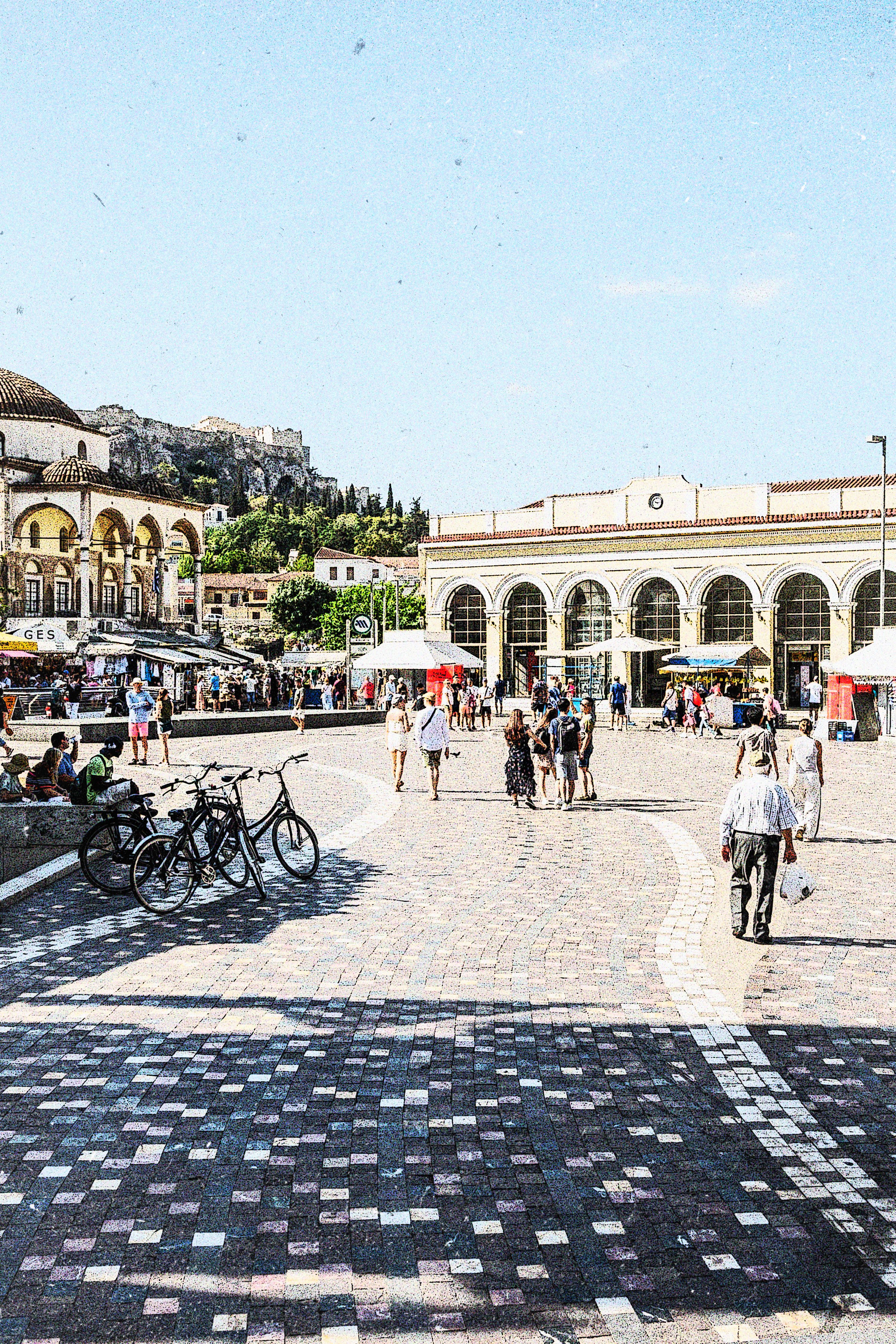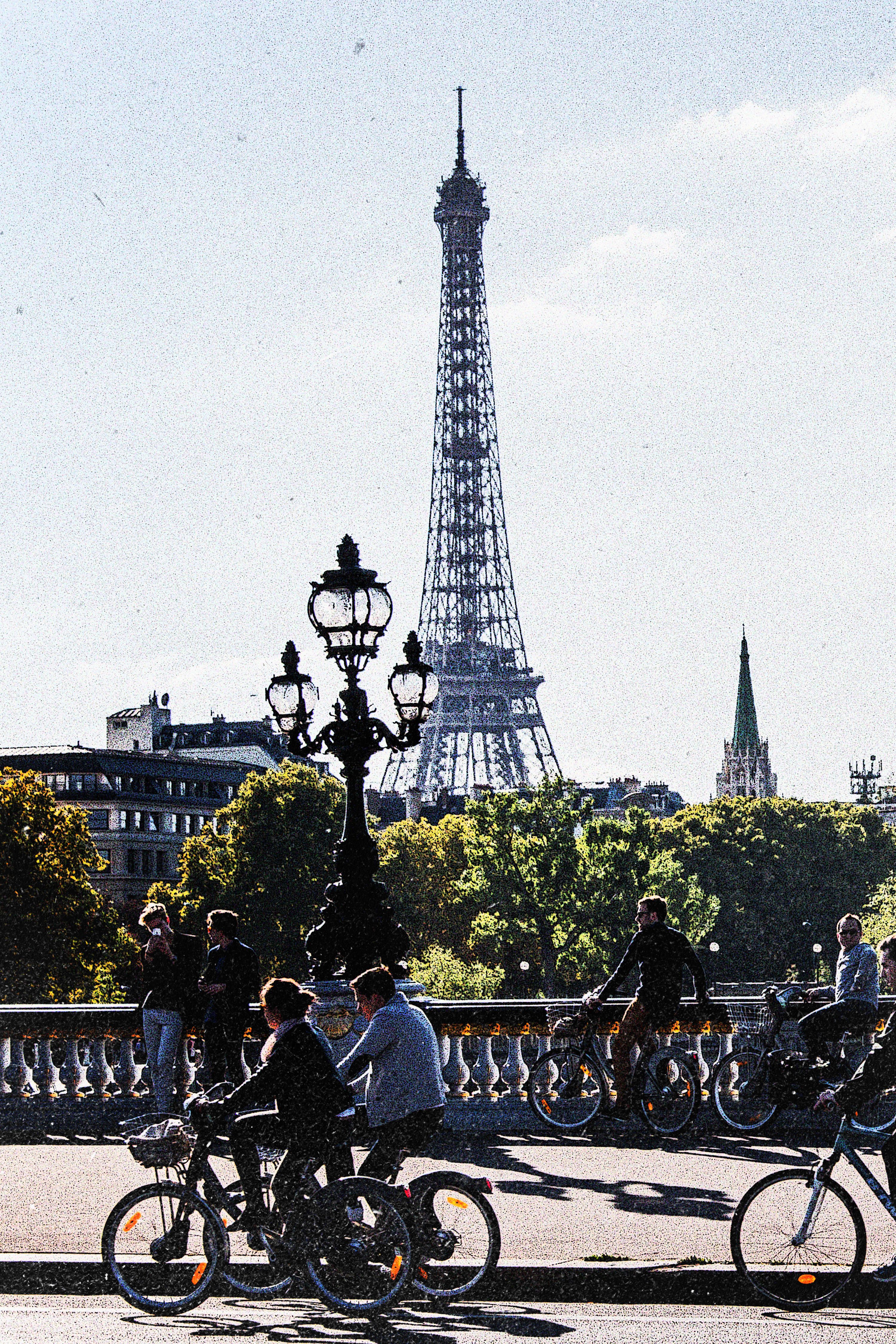Cities and Heat: Solutions and Innovation
How Athens is tackling extreme heat with nature-based strategies, public awareness, and inclusive urban planning — an interview with Elissavet Bargianni, Chief Heat Officer of Athens

In 2021, Athens became the first city in Europe to appoint a Chief Heat Officer (a public official responsible for heat-related issues). You now hold this position. How was this decision made, and what are the goals of this role?
"Athens has been dealing with heat-related challenges for many years—dating back to the time of Eleni Myrivili, when climate adaptation was already a central issue for the city. We developed a resilience strategy for Athens with a 2030 horizon and, alongside that, drafted the city’s first climate action plan, covering both mitigation and adaptation—with a strong focus on adaptation and a dedicated heat plan. Then, in 2022, we updated that plan based on the guidelines of the Paris Agreement and had it approved by C40. Even then, much of the work focused on adaptation. We knew this was a crucial issue: Athens is a very densely populated city. It’s something you can feel even as a visitor.
At a certain point, public complaints started to emerge about the heat and the need to protect the most vulnerable members of the population. So we launched a large-scale program, working across municipal departments—and we’re still doing so. That’s why it wasn’t surprising to create the role of Chief Heat Officer. The issue was already a top internal priority, and several technical projects were already underway around awareness and preparedness. Within the framework of our climate plan, this was an almost natural decision. Many heat-related actions already existed in the city, so the role was also a well-timed opportunity. Sometimes, timing is everything. Eleni Myrivili was a very dynamic figure, deeply committed to the issue of heat, so it was only natural that she became the symbolic figure of this effort in Athens."
Everyone knows about the extreme heat in Athens and its serious impacts on public health. What are the main priorities to reduce the impact of heat in the city?
"Heat is a highly cross-cutting risk—it’s of course an environmental issue, but also a public health one. So I wouldn’t say there was a single priority. It was really a combination of factors that brought us to this point. Combating heat requires engagement at all levels of city government and involves many actors who are not usually part of urban planning processes, such as ministries, other government agencies, NGOs, the Red Cross, and other organizations working on climate risks. That broad collaboration was essential.
Expanding green areas helps provide protection and manage temperatures in targeted zones. At the time, we were also working with the National Observatory of Athens, and we created maps—similar to those many cities now use—that combined urban and thermal data, highlighting green areas and vulnerable populations. These zones almost perfectly overlapped, clearly showing the link between a lack of green space and social vulnerability. Athens concluded that areas with less greenery are the most exposed to heat and home to the most fragile populations. The maps were quite basic, but I remember working on them myself to draw conclusions. It was absolutely clear where action was needed—those problem areas are still critical today.
It’s incredibly difficult work and it can’t be solved overnight. Raising awareness and preparing the city to bring nature back in requires a change in how technical departments approach their projects—and that takes time."
The issue of public awareness is crucial. Have you organized any campaigns or alert systems to inform and prepare citizens during heatwaves?
*"I’d like to share with you the CoolAthens project, which can give you a clearer picture of our intervention plans. As for categorization and public information, there’s a lot of material, and I believe it can serve as a useful roadmap for other cities—offering very clear indications of what we’re doing, what we’ve already done, and what we plan to do. For example, we trained our municipal health department staff in collaboration with the Hellenic Red Cross. There was a program called Help at Home, designed to prepare for the effects of heatwaves and assist vulnerable individuals. We also have a municipal clinic hotline to provide information and support to residents. In addition, we operate Extrema Global, an app that can be downloaded on smartphones and is useful even for visitors. For example, 116 is the number to call if someone is experiencing a heat-related emergency. But all of this is accompanied by preventive actions that provide guidance on how to cope with heat. We inform people about how to behave during hot periods or official heatwave alerts—how to keep homes cool, and what to do if you witness someone suffering from heatstroke."**
You're clearly taking a systemic approach, considering all risk factors—including prevention. It’s a virtuous method.
"Yes, I really think it will be useful. Together with the City of Athens, the National Observatory of Athens, and the Arsht-Rock Resilience Center, we started categorizing heatwaves. We assembled a very strong scientific team. They used the correlation between two decades of historical weather data and mortality data provided by ELSTAT.
For Athens—and now also for five other Greek cities—we’ve implemented an alert system that indicates what actions to take and what to expect, using a scale from 0 to 3. Heatwaves are categorized according to their level of risk to human health, so we can better protect both citizens and visitors.
We’re also part of the European REACHOUT program, through which we’ve developed climate studies for Athens and gained more insight for public awareness. Schools and other institutions have asked us to adapt this material to promote it in educational settings and provide practical guidelines."
Your goal is to promote widespread awareness, alongside collaborative work. The municipality, citizens, and all levels of government should take part in this major project.
"Right now, we’re preparing a major public information campaign on heat, because the danger is real, and citizens need to know that we are actively working on this issue. It’s cross-cutting—it touches health, green infrastructure, and every part of how the city functions.
Heat is something we've been living with for years. It’s crucial to recognize and understand how deeply heat risk affects urban life. For example, extreme heat can cause a drop of 10% or more in commercial activity because people avoid going out. There's also an increase in air conditioning use, which can overload the energy system if it’s not prepared—or drive up mobility patterns in line with weather forecasts.
There are also risks for the city’s green heritage, since natural ecosystems aren't adapted to these extreme conditions. For instance, in Athens we have large areas with pine trees. Pines don’t need a lot of water, but with constant summer heat, they become stressed, weakened, and more susceptible to disease or infestations by fungi or insects. They don’t die from heat directly, but a chain reaction begins that can eventually kill them.
We can't just water plants as much as we want—that would require excessive water use. And we’re already starting to face water scarcity issues in Athens. In some areas, the soil doesn’t retain water well, so it doesn’t nourish the plants properly. So what do we do? We must think about water recycling, avoid extracting new resources whenever possible, and find alternatives.
It’s not an optional choice—we have to do it. In Athens, for example, we have an ancient aqueduct, which used to bring water from the north of the city to the center. Today, there’s an ongoing discussion among the relevant authorities about how to reuse that water—for example, for irrigation or cleaning—rather than letting it go to waste."**
Your research prioritizes heat. Have you changed your approach to urban regeneration? We’re thinking not only of green areas but also of buildings, which can become extremely hot. That’s an important aspect as well.
"Absolutely. What we did last year, with the new city administration and the new mayor, was to establish an Energy Alleviation Office. This office focuses on people living in energy poverty. Here, citizens can get advice on how to protect themselves from heat (and cold), how to retrofit their homes to improve resilience to extreme temperatures. We also launched energy assistance programs—thanks in part to funding from C40.
This year, in just two months, Mayor Doukas has already helped about 60 people in Athens affected by energy poverty by removing the municipal tax from their utility bills. This had never happened before. We tried to do it as part of our financial relief measures, because this tax—especially in Athens—is quite high.
We also carry out energy audits to assess building conditions and determine how to intervene. Of course, this is a new structure—a new initiative for Athens—and we hope it can grow, become better equipped, and receive more funding. Because funding is always a challenge. But once you start taking action and move decisively in a clear direction, it becomes easier to secure resources. You demonstrate expertise and commitment, and people begin to believe in what you’re doing—they support you."
The Energy Alleviation Office is a very interesting idea. As for public spaces, do you have current projects in squares or parks that apply this approach?
"Yes, we do. I’m thinking of the Climate Action Plan 2022, which includes nature-based solutions to improve thermal comfort for residents in public spaces. We’ve launched a project to create green corridors in the city.
It’s a major initiative that required a long planning process because it involves a massive number of approvals—from the Ministry of Culture (which in Greece is never simple), to traffic studies, clearances from various institutional levels, stakeholder involvement, and final approval by the municipal council. It’s a real bureaucratic cycle to get through. In the end, you also have to prepare all the documents for the public tender.
In any case, the documents are nearly ready, and we’ve included the construction of three green corridors in our technical program. These corridors will connect green and public spaces: one in the Plato’s Academy district, another in Exarchia, and the third in northern Athens. The green corridors have been specifically designed to lower surrounding temperatures. A large consortium worked on the planning, using nature-based solutions to mitigate heat and increase the resilience of public spaces. The project was initially funded by the EIB (European Investment Bank) through what was called the Natural Capital Financing Facility."
Have you launched a greening project? Are there specific places already showing this new approach?
"Recently, we created a microforest with the support of sponsors and funding partners. Our goal is to plant 5,000 trees every year. We met that goal for 2024 and aim for another 5,000 in 2026. Various initiatives are underway, and we’re also renovating housing and public parks.
We’re leading a major project as part of the EUI (European Urban Initiative) called CoolingAthens. It focuses on creating cooling spaces through the use of water. It’s a large consortium, with many partners and a participatory process. We’ve established five permanent and two temporary water-based cooling stations around the city. The goal is to restore water to its rightful place. Athens once had rivers—water was a visible presence—but today, it’s mostly absent from the urban landscape. We want to bring it back. It’s also a cultural project: reintroducing water into public spaces."
You started working on these issues about four years ago, launching new tenders and projects. Is there public support for this kind of policy? In Greece, as elsewhere, reducing private car use is not always popular.
"Of course, but you have to keep pushing forward. We’re carrying out a project called Superblock, which is part of the European Ascend program—a pilot initiative for cities. We want to redesign and unify an area in Athens’ 6th district, where heat is a major problem. Community engagement is absolutely essential there: schools, the local church, neighborhood groups, active NGOs. There are groups that support interventions like pedestrianization or traffic control, and we’re using this project to create green spaces, reduce traffic, and generate renewable energy through solar panels. We’re also trying to measure the energy we produce.
We need the involvement of all stakeholders. With the new administration, Athens now has a new Deputy Mayor, Mr. Chrysogelos, founder of the city’s Climate Forum and Youth Climate Council. Our goal is to activate meaningful tools to engage stakeholders across projects—building shared strategies and consensus around what we’re doing is both very important and very effective."
Have you identified priority neighborhoods to focus on?
"Athens, like Rome, is very spread out, and we know that some neighborhoods are also socially more fragile—so that’s where we need to start. It’s no coincidence that the area where we’re launching this pilot project, the Superblock, has been identified as one of the city’s lower-income, multicultural, and densely populated zones—but also one with remarkable architecture.
It’s a heat trap, but at the same time, it offers clear opportunities for intervention. We want to work in places where people and the community can see tangible results. It’s an important residential area. Plus, there’s a central, highly visible section where we’ll be doing another urban regeneration project."
How are you financing all these interventions?
"We secured funding by applying to the European pilot cities program, and we’re also collaborating with the Polytechnic University. It’s a European project, but we’ll need additional funding in the future. The European funding was our starting point.
We don’t have substantial state funding—traditional or regular sources are very limited. We did receive some funds from the Recovery Plan, but they’ve already been allocated. One of the main interventions funded through that source is in an area called Eleonas, in the western part of the city, which is the most heat-vulnerable area. There, we plan to create a large park next to an athletics stadium. That entire zone will be transformed into a green space, and it’s a very important project, to which a large portion of those funds will go.
We’re constantly looking for ways to combine different funding sources. When we have the chance to apply for a European call—since these are competitive and we may or may not win—we go for it. Then we try to match it with other resources, even small amounts from regular city funding, for example, for tree planting or similar initiatives, or by reallocating funds from other projects.
We try to take a holistic approach and seize every opportunity, also thanks to our participation in networks like C40. But it always depends on the specific case."
An interesting aspect of this new approach is that you created the role of Chief Heat Officer to tackle the issue of extreme heat. Have there been other changes within the administration?
"I don’t think cities, in general, can go much further unless they break down silos, especially given the shrinking resources. Breaking down departmental boundaries for climate action is essential. Collaboration between offices is crucial—urban greenery, urban planning, architecture, everything. A broader understanding of how the system functions is needed.
We’ve been fortunate because we work in a networked way—but that’s not something you build overnight. It takes a deliberate choice, carried forward over years. It’s a mindset, a consistent approach. And it’s also about personality. Sometimes you meet people who say, ‘I did what I was asked, and that’s enough.’ But real change requires a combination of factors: people’s willingness, persistence, and the ability to think outside the box. It’s about giving direction, coordinating, seeing the bigger picture, and building awareness.
I’m part of the Resilience and Sustainability Office, and I don’t only deal with heat—I work across many issues related to the city’s overall stability. That gives me a broader perspective on the challenges."
Is there a project you’ve already completed or renewed in Athens that you feel reflects the shift brought about by this new approach?
"Yes, we carried out a major renovation of the National Garden. It’s a historic park, and it includes an aqueduct that irrigates the garden. We did extensive work—taking care of the trees, pruning them, treating them with great attention. It was high-quality work.
This is very important for Athens—not just environmentally, but also educationally, to teach care and respect for trees. These are large, mature trees that are valuable for children, schools, and for offering a cool experience in the heart of the city.
We’ve also pedestrianized some areas of the city and included nature-based solutions. People feel safer and can walk more comfortably—under trees or in small sunken parks, the so-called pocket parks. These are small green spaces instead of asphalt. Even if they’re small, they’re visible, tangible.
We’ve also renovated some fountains, which help lower temperatures thanks to the cooling effect of water. Another interesting project is the increase in the number of public drinking fountains across Athens. We want to have more public water points in the city. That’s essential for heat protection—during a heatwave, immediate access to water is crucial.
When you see someone struggling in the heat, the first thing you do is give them a glass of water or wet their head. Staying hydrated and having access to public water is vital."
Finisci di leggere l'articolo
Inserisci la mail per ricevere un link ai nostri abbonamenti
Oltre all’articolo sbloccato, riceverai la nostra newsletter settimanale principale Eutopica, oltre a occasionali aggiornamenti e offerte. Puoi annullare l’iscrizione in qualsiasi momento. Per maggiori informazioni, visita il nostro accordo con l’utente e l’informativa sulla privacy.
Ottieni l'accesso completo a Eutopica Iscriviti
Sei giá iscritto? AccediTAGS:
ClimaEutopica è un trimestrale di scienze urbane edito da ALI-Press srl, Società editoriale di ALI - Autonomie locali italiane Eutopica segnata al registro della stampa del Tribunale di Roma al numero 60/2025 con decreto del Presidente di Sezione del 5/6/2025. Il Direttore Responsabile è il Dottor. Valerio Lucciarini De Vincenzi.
SEDE LEGALE
Sede legale Via delle Botteghe Oscure 54 00186

